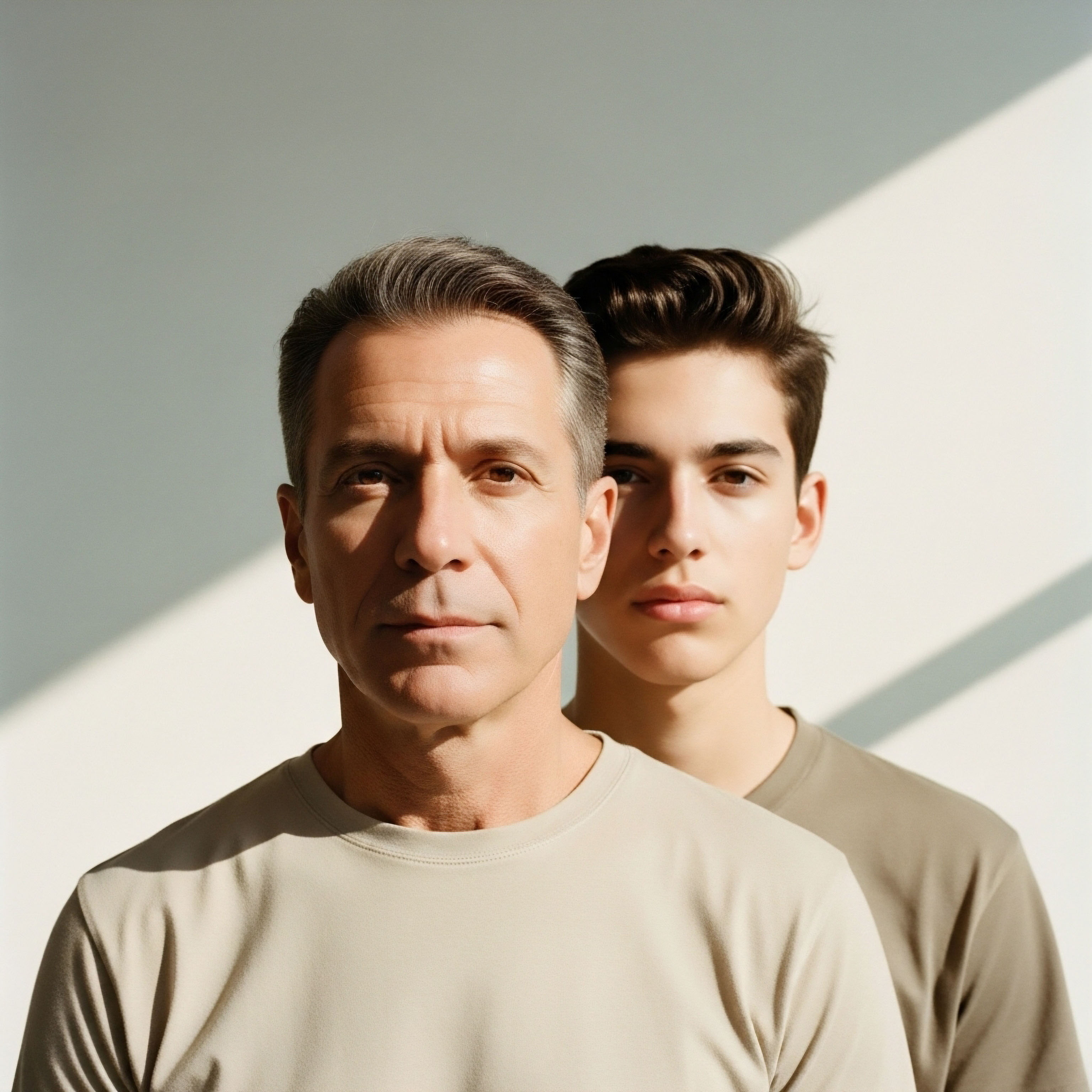

Fundamentals
You have embarked on a protocol to restore a fundamental component of your vitality. The decision to begin testosterone replacement therapy is often born from a collection of deeply personal symptoms a persistent fatigue that sleep does not resolve, a subtle decline in physical strength, or a quiet fading of your inner drive.
You receive the treatment, a precise biochemical key intended to unlock a more functional state of being. Yet, the profound shift you anticipated may feel incomplete. The energy is better, yet a layer of sluggishness remains. This experience is valid, and it points to a foundational truth of human physiology. Your body is an integrated system, a network of countless interconnected processes where no single input works in isolation.
Testosterone replacement therapy provides a powerful, corrective signal. Its purpose is to restore circulating levels of a critical androgen, directly addressing a state of deficiency. This hormone is a primary messenger for cellular repair, muscle protein synthesis, metabolic regulation, and neurological function.
When its levels are optimal, it instructs tissues throughout the body to operate with greater efficiency. Muscle cells are prompted to grow stronger, fat cells are signaled to release their stored energy, and brain cells are supported in functions of mood and cognition. The therapy itself is the act of delivering this essential message.

The Metabolic Environment
The effectiveness of that message depends entirely on the environment in which it is received. A sedentary lifestyle creates a specific, challenging metabolic environment. Extended periods of physical inactivity fundamentally alter the body’s internal chemistry. One of the most immediate consequences is the accumulation of visceral adipose tissue, a type of fat stored deep within the abdominal cavity.
This tissue is metabolically active, functioning almost like an unwanted endocrine organ. It produces inflammatory signals and, critically, an enzyme called aromatase. The primary function of aromatase is to convert testosterone into estrogen. Therefore, a sedentary body actively works to transform the very hormone you are replacing into a different one, directly countering the therapy’s objective.
This process is compounded by other systemic changes. Inactivity promotes a state of low-grade chronic inflammation, which disrupts the delicate signaling pathways that govern hormone production and action. It can elevate levels of cortisol, the body’s primary stress hormone, which has a directly antagonistic relationship with testosterone.
Furthermore, a lack of physical exertion disrupts sleep architecture, the deep, restorative phases of which are essential for the body’s entire hormonal cascade to function correctly. The result is a biological landscape that is resistant to the benefits of hormonal optimization. The therapeutic signal is being sent, but the internal terrain is unprepared to receive it and act upon it effectively.
A sedentary lifestyle fosters a metabolic state that actively resists and diminishes the intended effects of testosterone therapy.

Movement as a Systemic Catalyst
What makes an active lifestyle so important for someone on a hormonal optimization protocol? Physical activity, particularly a combination of resistance training and cardiovascular exercise, does more than just burn calories. It acts as a powerful catalyst that reshapes the body’s entire metabolic and signaling environment, making it exquisitely receptive to testosterone.
Exercise directly combats the negative effects of a sedentary state. It reduces visceral fat, thereby lowering the activity of the aromatase enzyme and preserving the testosterone being administered. It lowers chronic inflammation, allowing hormonal signals to be transmitted with greater clarity. It improves insulin sensitivity, a critical factor for metabolic health that is deeply intertwined with androgen function. It helps regulate cortisol and promotes the kind of deep sleep that is necessary for systemic repair.
Engaging in regular physical activity prepares the body to make full use of the therapy. It is the process of tuning the engine so it can efficiently burn the high-quality fuel being provided. The experience of renewed vitality comes from the synergy between the restored hormone levels and a body that is primed to use them.
One study found that men who combined TRT with lifestyle improvements had a 76% continuation rate with their therapy, compared to a 24% drop-off for those who did not, indicating a much greater satisfaction with the results. This highlights that the therapy is a component of a larger strategy for wellness, with personal agency and daily habits determining the ultimate outcome.


Intermediate
To understand how a sedentary lifestyle can impede the progress of a clinically supervised hormone optimization protocol, we must examine the specific mechanisms at the cellular and systemic levels. The goal of a protocol like Testosterone Replacement Therapy (TRT) is to re-establish physiological androgen levels, but its success is measured by the symptomatic and functional improvements in the individual.
These outcomes are contingent upon a series of biological events that occur after the hormone is administered. A lack of physical activity systematically interferes with these downstream processes, creating a state of functional resistance.
A common TRT protocol for men involves weekly intramuscular or subcutaneous injections of Testosterone Cypionate, an esterified form of testosterone that allows for a steady release into the bloodstream. This is often paired with other medications designed to maintain a balanced endocrine system.
For instance, Gonadorelin may be used to stimulate the pituitary gland, preserving natural testicular function and fertility. Anastrozole, an aromatase inhibitor, may be prescribed to block the conversion of testosterone to estrogen, managing potential side effects like water retention or gynecomastia. The objective of this multi-faceted approach is to create a hormonal profile that is both therapeutic and balanced.

The Cellular Gates and Insulin’s Role
How does testosterone exert its effects on a cell? The hormone travels through the bloodstream, often bound to carrier proteins like Sex Hormone-Binding Globulin (SHBG). To act, it must detach and enter a target cell, where it binds to an Androgen Receptor (AR).
This hormone-receptor complex then moves into the cell’s nucleus and initiates the transcription of specific genes, leading to effects like muscle protein synthesis. A sedentary lifestyle compromises this process primarily through its impact on insulin sensitivity.
Physical inactivity is a leading driver of insulin resistance, a condition where cells in muscle, fat, and the liver become less responsive to the hormone insulin. Insulin’s primary job is to manage blood glucose, but it also plays a crucial role in overall metabolic health and cellular signaling. When insulin resistance is high, the body must produce more insulin to achieve the same effect, leading to a state of hyperinsulinemia. This metabolic dysfunction has direct consequences for TRT:
- Altered SHBG Levels ∞ High insulin levels can suppress the liver’s production of SHBG. While this may seem beneficial by increasing “free” testosterone, chronically low SHBG is a marker of metabolic disease and can disrupt the delicate balance of hormone transport and availability.
- Impaired Receptor Signaling ∞ The intracellular pathways that insulin and testosterone use are deeply interconnected. The chronic inflammation and oxidative stress that accompany insulin resistance can blunt the sensitivity of the Androgen Receptor itself, meaning that even with sufficient testosterone available, the cell’s ability to respond to it is diminished.

Aromatization and the Visceral Fat Factor
One of the most direct ways a sedentary lifestyle negates TRT is through the process of aromatization. As mentioned, visceral adipose tissue is a primary site for the aromatase enzyme. The more visceral fat an individual carries, the higher their systemic aromatase activity.
This creates a situation where a significant portion of the administered testosterone is converted into estradiol, a potent form of estrogen. While some estrogen is necessary for male health, excessive levels relative to testosterone can lead to a host of undesirable effects, including reduced libido, increased body fat, and mood disturbances, effectively canceling out the intended benefits of the therapy.
This is why an aromatase inhibitor like Anastrozole is often included in TRT protocols. However, a lifestyle that promotes the accumulation of visceral fat forces a reliance on this medication. An active lifestyle that reduces visceral fat through exercise and improved nutrition naturally lowers the body’s aromatase activity, creating a more favorable testosterone-to-estrogen ratio and potentially reducing the need for or dosage of ancillary medications.
An active lifestyle enhances androgen receptor sensitivity and reduces hormonal conversion, allowing testosterone therapy to function with greater efficacy.

What Is the Synergistic Effect of Exercise?
Exercise does more than just counteract the negative effects of being sedentary; it actively potentiates the benefits of TRT. A pilot study published in 2016 provided clear evidence for this synergy. Researchers took a group of men with low testosterone and a sedentary lifestyle and divided them.
Both groups received TRT for 12 weeks, but one group also participated in a supervised exercise program. The results were telling. The group that combined TRT with exercise showed significantly greater improvements in both their serum testosterone levels and their symptom scores compared to the group receiving TRT alone. This demonstrates that exercise creates an environment where the therapy can work more effectively.
The mechanisms behind this synergy are multifaceted:
- Increased Androgen Receptor Density ∞ Resistance training, in particular, has been shown to increase the number of androgen receptors in muscle tissue. This is like building more docking stations for the testosterone to bind to, enhancing its muscle-building (myotrophic) effects.
- Improved Metabolic Health ∞ Both aerobic and resistance exercise improve insulin sensitivity, reduce visceral fat, and lower inflammation. This creates a systemic environment that is highly conducive to optimal androgen signaling.
- Enhanced Durability ∞ The same 2016 study followed the participants for 8 weeks after TRT was discontinued. In the TRT-only group, testosterone levels and symptom scores declined significantly. In the group that continued to exercise, the improvements were much better maintained, suggesting that the adaptations from exercise create a more resilient and self-sustaining hormonal and metabolic system.
| Metric | Sedentary Individual on TRT | Active Individual on TRT |
|---|---|---|
| Aromatization Rate | Elevated due to higher visceral fat, increasing testosterone-to-estrogen conversion. | Lowered due to reduced visceral fat, preserving testosterone. |
| Insulin Sensitivity | Often impaired, leading to metabolic dysfunction and blunted cellular response. | Improved, enhancing cellular signaling and nutrient partitioning. |
| Androgen Receptor Sensitivity | Can be blunted by chronic inflammation and oxidative stress. | Enhanced, particularly in muscle tissue, leading to better functional outcomes. |
| Symptom Improvement | Noticeable, but may be incomplete or accompanied by side effects. | Significantly greater, with improvements in energy, body composition, and mood. |
| Therapeutic Durability | Benefits decline quickly upon cessation of therapy. | Benefits are better maintained post-therapy due to improved underlying physiology. |


Academic
The interaction between exogenous testosterone administration and a sedentary phenotype represents a complex interplay of endocrinology, metabolic science, and cellular biology. To fully comprehend why physical inactivity can substantially attenuate the efficacy of Testosterone Replacement Therapy (TRT), one must look beyond serum hormone levels and examine the downstream determinants of androgen action.
The central thesis is that a sedentary state induces a systemic environment characterized by insulin resistance, chronic low-grade inflammation, and altered adipokine signaling, all of which converge to impair androgen receptor (AR) function and promote unfavorable hormonal metabolism. The therapy may successfully normalize total and free testosterone concentrations, yet the physiological and clinical response is muted because the target tissues are biochemically non-receptive.

The Hypothalamic-Pituitary-Gonadal-Adipose Axis
The classic model of the Hypothalamic-Pituitary-Gonadal (HPG) axis, while foundational, is incomplete without considering the influence of adipose tissue, particularly in the context of a sedentary lifestyle. Visceral Adipose Tissue (VAT) is not a passive energy reservoir; it is an active endocrine organ that secretes a variety of signaling molecules, including leptin, adiponectin, and pro-inflammatory cytokines like Tumor Necrosis Factor-alpha (TNF-α) and Interleukin-6 (IL-6).
In a sedentary individual with increased VAT, this creates what can be termed the HPGA axis, where adipose-derived signals exert significant regulatory pressure.
The most direct interference is the aromatization of androgens to estrogens within adipocytes, a process that directly depletes the pool of active testosterone provided by TRT. Beyond this, the inflammatory cytokines produced by VAT have been shown to have suppressive effects at all levels of the HPG axis, potentially interfering with the intended feedback mechanisms of a TRT protocol that aims to work alongside endogenous production (e.g.
using Gonadorelin). These cytokines also contribute to a state of systemic inflammation that directly impairs androgen signaling at the cellular level.

How Does Inflammation Impair Androgen Receptor Function?
The functionality of the Androgen Receptor is the rate-limiting step for testosterone’s biological action. The binding of testosterone to the AR is just the first step. The AR-ligand complex must then undergo conformational changes, translocate to the nucleus, and recruit a host of co-activator and co-repressor proteins to modulate the transcription of androgen-responsive genes. Chronic inflammation, a hallmark of the sedentary phenotype, disrupts this intricate process.
For example, signaling pathways activated by TNF-α, such as the NF-κB (nuclear factor kappa-light-chain-enhancer of activated B cells) pathway, can directly interfere with AR function. NF-κB and the AR can mutually repress one another’s transcriptional activity.
In a pro-inflammatory state where NF-κB is chronically activated, its repressive action on the AR can lead to a state of androgen resistance, even when circulating testosterone levels are pharmacologically optimized. This provides a clear molecular basis for the attenuated muscle protein synthesis, lipolysis, and cognitive benefits seen in sedentary individuals on TRT.

Metabolic Inflexibility and the Role of Exercise
A sedentary lifestyle leads to metabolic inflexibility, the impaired ability of the body to switch between fuel sources (e.g. glucose and fatty acids) in response to nutritional or energetic demands. This is tightly linked to insulin resistance. Exercise induces profound metabolic adaptations that reverse this state. The key lies in the activation of AMP-activated protein kinase (AMPK), a master regulator of cellular energy homeostasis.
Acute exercise activates AMPK, which promotes glucose uptake into muscles and enhances fatty acid oxidation. Chronic exercise training leads to adaptations that improve baseline insulin sensitivity and metabolic flexibility. This has direct implications for TRT. By improving the metabolic health of the cell, exercise creates an environment where the anabolic and metabolic signals of testosterone can be properly executed.
Improved insulin sensitivity ensures that nutrients are efficiently partitioned into muscle for growth and repair, a process that is synergistic with testosterone’s action on protein synthesis.
| Study Parameter | Key Finding | Reference |
|---|---|---|
| Intervention | A 2016 pilot RCT compared TRT-only vs. TRT + supervised exercise in 50 sedentary men with LOH. | |
| Serum Testosterone | Both groups showed increased serum T at 12 weeks, with significantly greater increases in the exercise group. | |
| Symptom Scores (AMS, IIEF) | The TRT + exercise group demonstrated statistically significant improvements in symptom scores over the TRT-only group. | |
| Post-Therapy Durability | At 8 weeks post-TRT cessation, the exercise group maintained significantly better T levels and symptom scores. | |
| Mechanism Implication | Exercise provides synergistic effects on androgen levels and end-organ response, and improves the underlying pathophysiology, leading to more durable results. |

What Is the Role of Peptide Therapies in This Context?
For individuals seeking to maximize the benefits of hormonal optimization, peptide therapies can be a valuable adjunct. These are targeted signaling molecules that can help overcome specific points of resistance. For instance, Growth Hormone Releasing Peptides (GHRPs) like Sermorelin or Ipamorelin stimulate the body’s own production of growth hormone.
This can have synergistic effects with TRT, particularly in improving body composition by promoting lipolysis and lean muscle gain. This approach aligns with a systems-biology perspective, where multiple pathways are targeted to restore a more youthful and functional physiological state.
Peptides like PT-141 for sexual health or others for tissue repair can further complement a comprehensive wellness protocol, addressing specific concerns that may persist even with optimized testosterone levels, especially in a previously sedentary individual who is now becoming active.

References
- Low T Center. “A Sedentary Lifestyle Can Contribute to Low Testosterone.” 2024.
- Classicfit Health & Wellness. “How Lifestyle Affects Testosterone and the Success of TRT.” 2025.
- Kim, E. et al. “Exercise improves the effects of testosterone replacement therapy and the durability of response after cessation of treatment ∞ A pilot randomized controlled trial.” The World Journal of Men’s Health, vol. 34, no. 2, 2016, pp. 113-120.
- Oh, J.K. et al. “Exercise improves the effects of testosterone replacement therapy and the durability of response after cessation of treatment ∞ a pilot randomized controlled trial.” Urology, vol. 94, 2016, pp. 113-120. Sourced from PubMed Central.
- L, Anny. “How a sedentary lifestyle reduces testosterone levels in men.” Medium, 10 Feb. 2024.

Reflection

Listening to Your Body’s Dialogue
The information presented here provides a map of the biological terrain you are navigating. It connects the symptoms you may feel to the complex, silent dialogue happening between your hormones, your cells, and your daily habits. The science is a powerful tool, offering explanations and pathways.
It confirms that your personal experience of feeling that a therapeutic protocol is falling short is grounded in tangible physiological processes. The knowledge that a sedentary lifestyle creates metabolic headwinds is the first step. The true journey begins with introspection.
How does your body feel after a day of prolonged stillness versus a day with intentional movement? What are the subtle shifts in energy, mood, and clarity that you notice? This personal, empirical evidence is your most valuable data. The goal of any wellness protocol is to restore your unique system to its optimal state of function.
This requires a partnership between the clinical tools you are provided and the daily choices you make. Viewing your body as a responsive, adaptive system, and understanding that your actions are a constant part of that dialogue, is the foundation of reclaiming your full vitality.

Glossary

testosterone replacement therapy

muscle protein synthesis

testosterone replacement

visceral adipose tissue

sedentary lifestyle

chronic inflammation

does more than just

insulin sensitivity

metabolic health

testosterone cypionate

anastrozole

gonadorelin

sex hormone-binding globulin

androgen receptor

protein synthesis

metabolic dysfunction

insulin resistance

adipose tissue

visceral fat

exercise does more than just

testosterone levels

hpg axis

metabolic inflexibility




